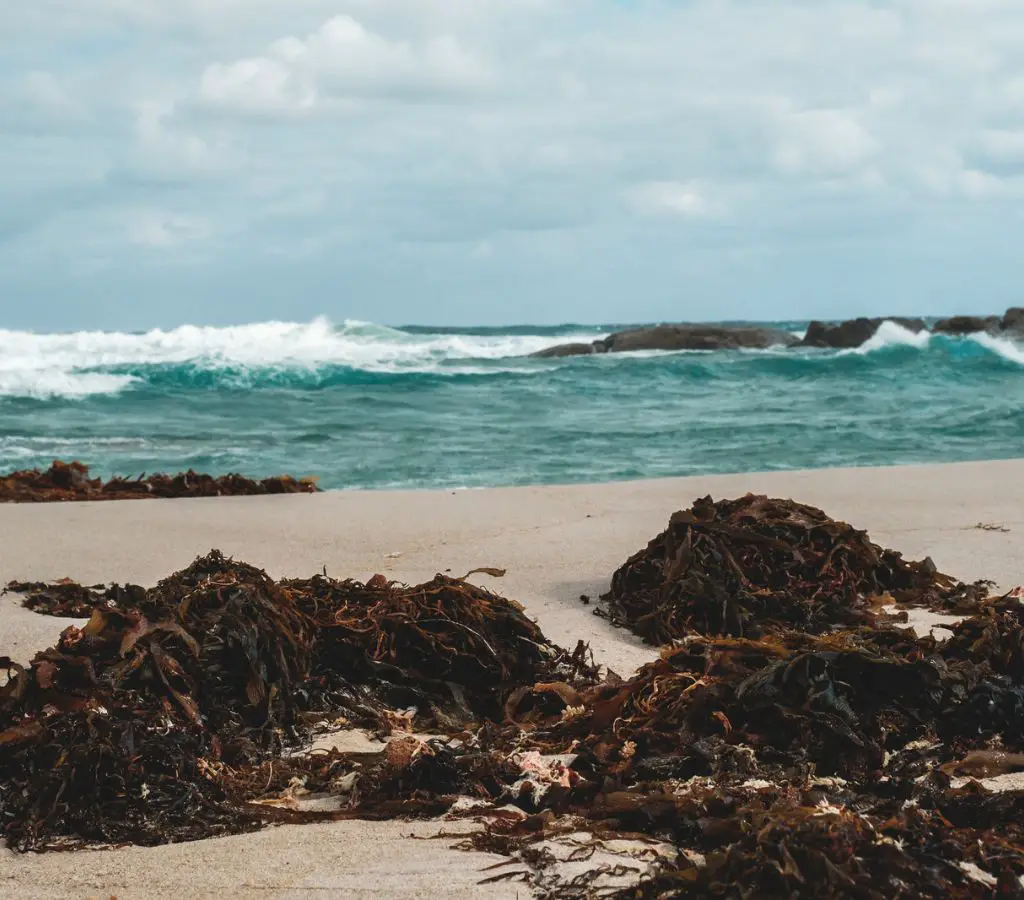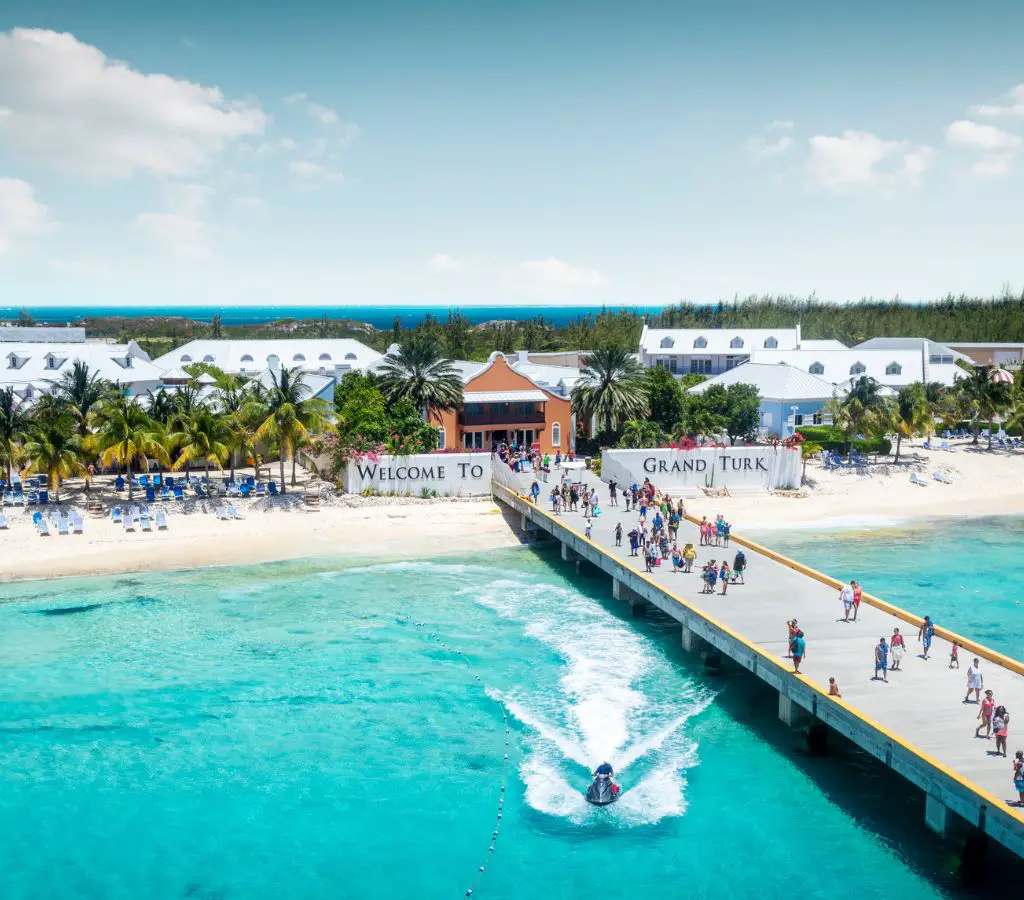Sargassum is a type of free-floating seaweed specific to the Atlantic Ocean.
It gets its name from the Sargasso Sea, located in the lower northern regions of the Atlantic. This macroalgae amasses into significantly large bodies and travels the ocean currents shoring on the Caribbean beaches.
When sargassum shores, it deteriorates after a few days emitting toxic gases and an overwhelming foul stench.
This article reveals all you need to know about the Turks and Caicos seaweed problem in 2023.
Turks and Caicos Seaweed Problem 2023
Table of Contents
Current (Present) Seaweed Conditions in Turks and Caicos

Sargassum is both beneficial and harmful to the environment and the human population. It produces oxygen, provides nutrients, and is home to over a hundred diverse marine wildlife species. It floats thanks to berry-shaped pockets containing oxygen.
Mostly, sargassum never falls to the ocean floor. Instead, it’s a hydrophyte, meaning its entire life cycle occurs on the tide’s surface. When it does, it breaks and dissolves, supplying the ocean currents with nutrient-rich food. The sargassum grows to about several meters in length.
This seaweed was first spotted by the ships of Christopher Columbus. It’s possible that Portuguese sailors named it so because it looks like bundles of grapes. It appears golden brown and, unfortunately, ruins the scenic beauty of the pristine Caribbean beaches.
From 2011, during the past ten years, there has been a considerable rise in sargassum levels on beaches. In 2018, an Atlantic sargassum belt stretched from West Africa to the Gulf of Mexico.
This year, satellite images have shown a sargassum mass that stretches over 5000 miles.
Researchers cite various reasons for the rapid expansion of sargassum over the past ten years. These include deforestation, climate change/warmer ocean currents, runoff from agricultural nitrogen-rich fertilizers, oceanic chemical change and sewage waste.
In May 2022, it amassed to 18.8 million tons.
As of April 2023, Turks and Caicos have low seaweed levels. This is despite the massive seaweed body steadily making its way from the east. However, there are moderate amounts of sargassum found on the beaches, and these are manageable.
According to Trip Advisor, the various beach resort’s management makes a tremendous effort to clear away the seaweed that plagues the shoreline. As this problem has occurred over the past ten years, much is done in preparation and maintenance.
Efforts to manage the algae problem include buying new equipment and disposing of seaweed daily. The equipment consists of a lightweight utility tractor, beach rakes, bin bags, resort staff and personnel dedicated to combating the sargassum tide.
Various factors contribute to seaweed shoring along a coastline. Primarily easterly winds are responsible for the traveling macroalgae.
In addition, so are the northeastern swells and the ocean currents. The four main circulating ocean currents of the Sargasso Sea carry the algae.
Turks and Caicos have beaches that are sheltered from the eastern winds.
Turks and Caicos’ seaweed season is usually from June to November. At the same time, sargassum is prolific throughout the remaining Caribbean from March to June.
Related posts
Punta Cana SEAWEED Problem [2023]: Everything You Need To Know!!
Jamaica Seaweed Problem 2023 [Updated]: Everything You Need To Know!
Aruba SEAWEED Problem (2023): Everything You Need To Know!!
Puerto Rico Seaweed Problem 2023: Everything You Need to Know!
Bermuda Seaweed Problem 2023: All You Need To Know Before Visiting!
Antigua Seaweed Problem 2023: Everything You Need to Know Before You Visit
Turks and Caicos Seaweed Forecast for 2023
Forecasting Sargassum seaweed on beach fronts is problematic as plenty of variables participate in the problem. Ph.D. professor Yuyuan Xie heads the Optical Oceanography Laboratory at the University of South Florida.
The lab’s marine scientists have developed the Satellite-based Sargassum Watch System (SaWS). They research, monitor, predict, and track the trajectory of sargassum daily via data collation, analysis, quality control, and distributing their findings on the SaWS web portal.
The optics lab uses remote sensing, optics, and satellite imagery to investigate the impact of oceanic currents, winds, and phenomena like the sargassum on coastline shores. From March 2023, a record-high amount of sargassum has accumulated east of the Atlantic and is moving west.
This sizeable sargassum seaweed accumulation increases the likelihood of it landing on the shores of beaches across the Caribbean and South Florida. However, the current seaweed situation of Turks and Caicos has low-to-mid levels. It’s advisable to prepare for an oncoming sargassum inundation.
Most Seaweed-Affected Beaches/Region in Turks and Caicos in 2023
The most seaweed-affected beaches or regions in Turks and Caicos in 2023 include Long Bay Beach, Blue Hills Beach, and Five Cays Beach. These beaches are the most exposed to easterly winds, which is the prominent factor in the traveling sargassum. Fortunately, these beaches aren’t frequented.
Geography is another determining factor of sargassum seaweed shoring. A windy tide carries the algae to the exposed shores of Ambergris Cays, Grand Turk, South Caicos, and the eastern aspect of North Caicos.
In the past, there was a case of excessive sargassum inundation in the channels between the small cays dividing the South and East Caicos. Often, the northern aspect of this channel receives an abundance of sargassum, and it becomes congested as a result.
However, for the most part, Turks and Caicos aren’t subjected to the prolonged accumulation of sargassum that other areas of the Antilles, Archipelagos, Caribbean, Lucayan, and South Florida are subjected to.
Best Seaweed-Free Beaches/Regions to Visit in Turks and Caicos in 2023
The best seaweed-free beaches or regions to visit in Turks and Caicos in 2023 include the renowned, breathtaking Grace Bay. Included is the scenic cruise journey’s end of Fort George Cay, Water Cay, Pine Cay, and Half Moon Bay. Generally, these are seaweed free.
Additionally, tourists, guests, and residents staying on the main island of Providenciales won’t experience any sargassum or seaweed issues.
The best beaches of the Providenciales with low-to-none seaweed levels are Grace Bay (mentioned above), Leeward, Bright Beach, Taylor Bay, Sapodilla Bay, and Malcom’s Road. Their immaculate beauty remains intact for all to enjoy.
There are numerous beaches on the Turk and Caicos shorelines, and seaweed accumulation is inevitable. There will always be at least some flotsam to expect. However, as you’ll see, minor seaweed amounts are a good thing.
Typically, sargassum is beneficial to upholding beaches’ natural structure and ecology. They prevent erosion, stabilize beach dunes, help delineate the sand and promote beach accretion. So, some sargassum is welcome on these beaches.
Conclusion
Currently, Turks and Caicos aren’t experiencing any significant seaweed sargassum problems. This is despite the considerable mass of sargassum traveling west across the Atlantic.
Generally, Turks and Caicos have seaweed issues from June to November. The beaches sheltered from the eastern winds, like the famed Grace Bay, maintain low levels as opposed to those exposed, like Long Bay Beach.
References
Sargassum Seaweed in the Turks and Caicos | Visit Turks and Caicos Islands (visittci.com)
Satellite Images: 5,000-Mile Seaweed Bloom Threatens Florida Beaches (businessinsider.com)
Seaweed blob? – Turks and Caicos Forum – Tripadvisor
Seaweed bloom: What is Sargassum and why are people worried about it? – BBC Newsround
